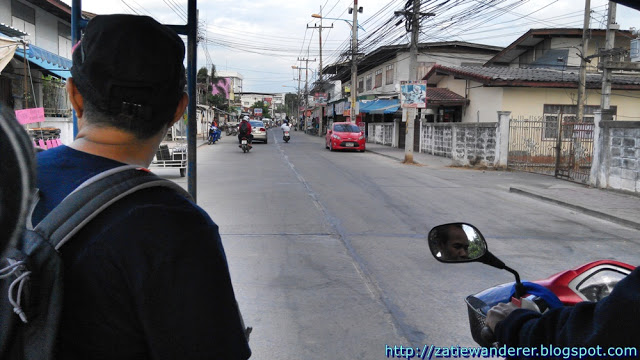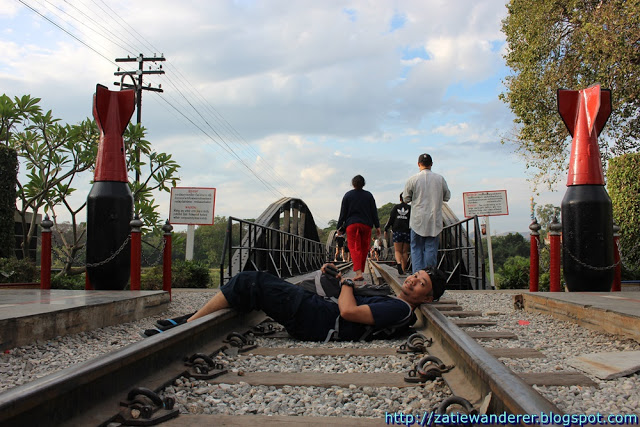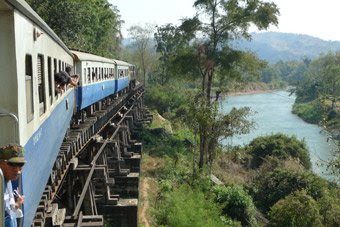Continued from Thailand – Laos Travel: Day 6 – Part 5 – Kanchanaburi Night Market. For pre-travel, please refer here.
Travel Date: January 3, 2017
Day: 7
Location: Kanchanaburi
At this point, the time is 8.06am. The atmosphere is so comfortable and peaceful.

Outside our room, we were presented with a view of mountains with reflections of the morning sunlight and the river that smelled naturally. Occasionally there is the sound of boats navigating on the River Kwai.
Behind me is the Kwai river heading towards the upper reaches of the river which also passes under the Death Railway bridge. This river originates from Lake Sinakharin which is still under Thai rule. The lake is huge with a length of 55km!

This is the direction downstream of the Kwai river. There is a bridge there with mountain views. The water that flows downstream will join the river flow from Lake Vajiralongkorn which is also so large with a length of 65km.

And the junction of these two lakes will continue to the sea which is the Gulf of Thailand. Remember the long bridge we crossed while taking the bus from Pak Tho to Maeklong Railway Station? That’s the same river that flows from here.
Across the river, there is a house that I think might be a maintenance place for boats and canoes.

This is the shape of VN Guesthouse’s floating house. I’m not sure if the bottom of the house is floating or there are hidden pillars. For those who have suffered from diseases such as Vertigo, it may not be suitable to stay here because the house may be rocking or undulating due to the river current even though its speed is moderate.

From the platform I was standing on you could see the main platform as soon as we entered the Rainbow Lodge. There is also a check-in counter, a mini restaurant/cafe and a snooker table. Due to time constraints, we did not have the opportunity to use the facilities here such as platforms/benches, hammocks, swings and lounge chairs.

After getting ready, we set off towards the main road. Not the highway facing Kanchanaburi Railway Station, but the same road we traveled yesterday. This time we will ride Motorcycle Tuktuk because the distance to the destination is 2.5km from Rainbow Lodge. For those of you who are still single and energetic, it’s good to walk. The fare charged is THB80 for one way after bargaining from the original fare of THB100.

We have arrived. Even though it is still early in the morning, many tourists have started coming. Alhamdulillah, the morning weather is sunny. To get here is not difficult, just search for “Death Railway” in Google Maps.

Here there are also many stalls, bazaars or morning markets selling lots of souvenirs.

Did you see the black bridge? Its popular name is “Bridge on the River Kwai”. For those who have seen the movie “The Bridge on the River Kwai” which was screened in 1952, and of course can’t wait to take a closer look.

Back in my secondary school, we studied the history of this Death Railway where Japanese soldiers mobilized and forced thousands of prisoners of war, including Malays, to build a railway all the way to Burma (Myanmar).
A little history ……
Kanchanaburi is located close to the Myanmar border. During World War II, Japan built a railway from Ban Pong, Thailand to Thanbyuzayat, Burma. Now it is known as the Death Railway.
The construction of this railway was intended to transport daily cargo to India in preparation for launching an attack on India in the future. Construction was carried out by prisoners of war and slaves from allied and Asian countries. The condition of these detainees was very bad and they were forced to work until they died.
Construction began in October 1942 and was completed a year later. Due to the extremely difficult terrain, thousands of prisoners died while working. It is believed that every single prisoner dies for every railway track that has been successfully installed.
In fact, the bridge was bombed by the allied coalition in 1944. Three sections of the bridge were destroyed. The bridge we see today is a rebuilt version referring to the original shape. Fragments of the original part of the bridge have been exhibited at the War Museum.
The bridge became famous around the world after its story was published through books and movies. Every year, a celebration is held on November 28 to commemorate the construction of this bridge as well as those who have been killed.
Two interesting attractions here are the bridge as well as the two wartime bombs. Is this the actual size of the bombs that hundreds were dropped from a plane during the war at the time? I’m not sure. If true, the size is very large. Or maybe this is a replica of a bomb dropped by the allied forces to destroy this bridge in 1944.

I also remember the story of my late grandmother in Gelugur, Penang during World War II. When the Japanese plane crossed the airspace, the war siren would sound loud and everyone ran into the hole built by the villagers. But I think, if the bomb fell nearby, maybe the hole could not accommodate the impact of such a large bomb.
Trains only pass through this railway track twice a day. So, do hurry up and take a picture. It is unknown when we will come here again, right?

There is also a floating restaurant here but it is not halal.

We then walked all the way over this bridge.

View of a Buddhist temple from the bridge. Looks like a rather large statue there.

When both my parents came here via a tour package, they had a ride on the floating lodge found here. This lodge has the concept of a dining hall but floats and moves around the river Kwai. Dinner will be served inside.

In the end, there is the flow of the river from upstream.

From here, the river flows downstream. Beautiful morning scenery with refreshing sun rays when it touches the skin of the face.

The construction of the new bridge was rebuilt by a company from Japan. Possibly the same company that designed and built it during World War II?

When stepping on this bridge, be careful. Furthermore when carrying a small child. For adults as well, don’t let your feet get stuck in the hole.

Then we headed to the runway at the end of the bridge. Deliberately want to see what’s there.

But before that, I looked back, which is the direction we came from earlier. Wow, how beautiful the mountain is at the end there when the sunlight shines on it.

The Buddhist temple began to look closer.

We’ve reached the end of the bridge. Eh, not yet!

At the bottom of the bridge, stalls are selling various goods. But it’s kind of quiet and the atmosphere is less popular here.

Ok. This is the end of the bridge. Looks like a local man is doing carpentering but not sure what he built. Probably a new fence for vehicles when trying to cross the railroad tracks.

Looks like a railroad worker guarding the traffic is sitting in the hut, hahaha! Mrs. Tatie rested for a moment in it as there was a chair to sit on.

From the edge of the hut, I found that there was a path leading down. And from here, I can see the extension of the bridge which is part of the whole bridge that is not located on the water.

Wild dogs abound here. In a somewhat anxious feeling, we ventured to go through it.
Pictured on the bridge felt to me as too common …. Well! Maybe we are the only travelers from Malaysia who took photos under this bridge ??

Aqif and I are under the bridge, Tatie is on top.

I wanted to walk all the way to the river, but time was running out. Actually, nothing is interesting below unless you want to see the architecture of the old bridge from the bottom.

Video of us walking on the iron bridge.
This trip is incomplete if you do not take pictures at this River Kwai Bridge station. Here there are also a variety of items for sale.

If a woman sees this fruit, she must be amused. Because I remembered a picture of a human body that had gone viral on Facebook before.

After that, we walked towards the bazaars by the bridge that we saw at the beginning. Actually, the attractions in Kanchanaburi are too many. Due to only staying one night here, then we had to rush to visit some other places before 12.00 noon.

A few tips for visiting Death Railway …
1. There are two ways to look around a Death Railway.
2. The first way is the same as we did.
3. Second, by taking a train from Thon Buri (Bangkok). The train will pass over the iron bridge and Wampo Viaduct and stop at Nam Tok train station. Because the train journey from Kanchanaburi to Nam Tok takes 2 hours (if directly from Bangkok, an additional 2 hours and overall journey estimated as 4 hours), then we had to cancel the intention to follow the second method.


4. If arriving in Nam Tok, there is another attraction which is Konyu Cutting and better known as Hellfire Pass (the name given by prisoners of war). The location is only 10km from Nam Tok station. It is there where many detainees die and there is a museum as well as the old site of a railway track that has been built or planned to be built along its 7km route. The site or trail has been refurbished and reopened by the Australian government as a memorial site and only 4km is available to the public.
5. Then, go back on the same train and stop at River Kwai Bridge Railway Station to enjoy the view of the iron bridge.
6. The information in Google also mentions the Three Pagoda Pass available along the route from Kanchanaburi to Nam Tok. Maybe you can find it if you come here.
7. More information on train schedules can be found here: https://www.seat61.com/Bridge-on-the-River-Kwai.htm
We continue our story here … Thailand – Laos Travel: Day 7 – Part 2 – Sales Bazaar and JEATH War Museum.





Leave a Reply